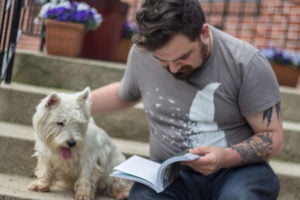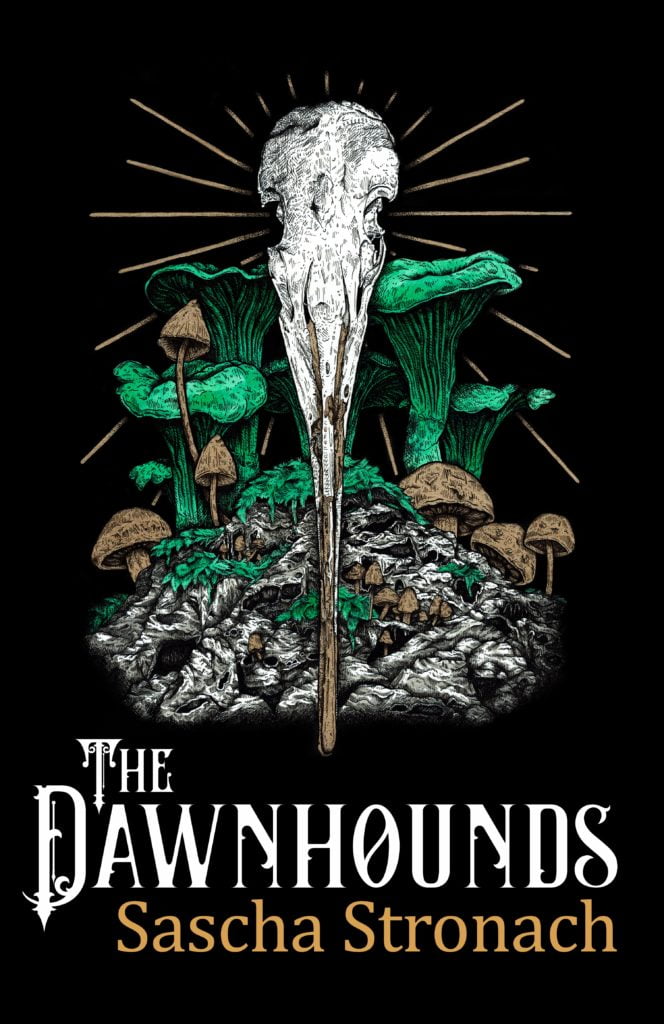 Sascha Stronach is a creature of unknown origin, said to dwell somewhere in the forests of the Wellington region. He is an exceptionally hairy hominid, believed to be a distant relative of mankind. Every year, hunters gather at the top of Ohiro Road for “StronaChon” and sell plush animals and cheap beer before charging into the park, whereupon they spend a pleasant afternoon accidentally tranquilising each other. His first novel, The Dawnhounds, was found in a small shrine made of sticks and castoff cans of VB. A team at Victoria University have stated it was in “remarkable condition”, and have passed it onto the experts at Unity Books for further study.
Sascha Stronach is a creature of unknown origin, said to dwell somewhere in the forests of the Wellington region. He is an exceptionally hairy hominid, believed to be a distant relative of mankind. Every year, hunters gather at the top of Ohiro Road for “StronaChon” and sell plush animals and cheap beer before charging into the park, whereupon they spend a pleasant afternoon accidentally tranquilising each other. His first novel, The Dawnhounds, was found in a small shrine made of sticks and castoff cans of VB. A team at Victoria University have stated it was in “remarkable condition”, and have passed it onto the experts at Unity Books for further study.
[ The Dawnhounds | Twitter | Insta | Bonus Twitter ]
Q: You help an author co-op in our fair city. How did you come to be a part of that? What’s the best customer story you’ve got from it?
A: We had some issues with our printers in the leadup to the launch and ended up going to YourBooks to get an emergency run of 100 copies printed off. They’re affiliated with the Underground Bookstore, and they passed my name on as somebody whose book might be worth stocking. It’s a fun time. Wellingtonians are a friendly lot to sell to. You sometimes get people coming in asking to meet author x and that’s always a good time; we pass these things on to each other, and it’s always buzzy to be the bearer of good news.
 Q: The Dawnhounds is a trail of redemption, the way back, maybe about paying for past sins. How did the idea of death not sticking come to you? How did you weld the amalgam of thief and cop together to make the wonderful Yat?
Q: The Dawnhounds is a trail of redemption, the way back, maybe about paying for past sins. How did the idea of death not sticking come to you? How did you weld the amalgam of thief and cop together to make the wonderful Yat?
I was waiting for a bus to catch a red-eye one night, and a homeless man sat down next to me and said “you died once, I can tell: you’ve seen the big guy,” and it’s the scariest fucking thing that’s ever happened to me. He then immediately tried to sell me P and it deflated the terror somewhat, but the moment really stuck with me. A few weeks ago, a reader approached me and said “Monkey is the guy you see when you try to commit suicide, right?” and that was a 1–2 punch that I’m still reeling from. I tell myself it’s confirmation bias and weird neurochemistry and the power of storytelling and I tell myself those things often at an increasingly high pitch, like they’re the only things stopping the walls from coming down.
I can’t speak to the universality of this, but I’ve heard it enough in a very certain cracking voice to believe it’s not just me: when a suicide attempt fails, you don’t feel like you survived—you feel like you died and came back. SFF is a place where you can discuss hard topics without looking them directly in the eye. This is my hardest topic; the thing I can—after ten years and a lot of therapy—talk about in small doses, but I don’t dare approach for 80,000 words. SFF let me write about it sideways, explore my pain and maybe inch towards catharsis. Depression has a way of making pain feel endless, inevitable, a sort of universal default state. It’s a lie, but it’s one that’s almost impossible to exorcise when it’s got its fingernails in you. I wanted to write against that: I wanted to throw colour and fire and family at it, to paint on the endless grey walls. I didn’t want to write a book about death, I wanted to write about rebirth. I wanted to write a book that would’ve pulled teenage-me through the night.
Shit, there’s a second part to this question, isn’t there? Yat’s damage is that she wants to help people but she’s terrible at it; she doesn’t listen to people and instead just enforces her solutions onto them. She’s internalised cop-thought pretty hard by the time we meet her, on a level where—in her opening scene—she almost arrests a kid just like her because she thinks it’ll scare him straight. The cops arrested her and set her straight so she assumes it works that way for everybody, and she goes about hurting people out of a desire to protect them. I wanted her hypocrisy to be staring her in the face from day 1, to set the stage for her turning around and actually learning to work with other people. I also wanted to break down the wall between Good Cops and Bad Criminals; one of the most noble people in a deeply corrupt force is the ex-thief who’s been demoted to the night shift. It was cool and noiry and let me explore crime on a more sympathetic level, as a product of a dysfunctional society rather than just Bad Man Do A Bad.
On a less mature level, I also wanted her to do cool thiefy roofrunning and it was a good way to justify it. Imagine me shouting “PARKOUR” and punching the air every time she does something cool. If I’m ever kidnapped and forced to sneak out clues coded in novels, I’ll write a protagonist who doesn’t find a way to Go Fast.
Q: There’s a cordyceps plague. It has a particular effect on humanity. A) What’s the effect, and B) what are you doing about it?
I spoke to a microbiologist after the book came out and it turns out I accidentally created a realistic plague. Sort of. I’d written it as just infectious spores, but it apparently acts more like a retrovirus (modifying and repurposing existing tissue into more of itself) that happens to use spores as a transmission vector. It does not and would not work in our world because there’s almost no way for it to cross the species barrier (the Kingdom barrier?) from a mycophage into human hosts, but this civilization is using fungal DNA as part of the gene-grafting process, which created a sort of bridge between fungal matter and human tissue that allowed for the mutation that sends everything sideways. tl;dr: it’s a mushroom virus that jumped to humans because they kept splicing themselves with mushrooms.
The spores are one of the only parts of the book that remain from the very first draft, which I wrote in 2013 when zombies were … I mean, they were overplayed, but I hadn’t admitted it to myself yet. There was no repurposing of flesh: they were just mushroom zombies and they had freaky mushrooms on their faces and exploded into spores when they died. I started writing before The Last of Us came out, okay? This book in no way rips off The Last of Us. I’m a totally original author without any influences whatsoever, and also the Industrial Revolution plague city the protagonist navigates with a mix of teleportation and parkour clearly rips off Dishonored, duh. Anyway, there was a moment where they were all trying to crawl up a mast to eat somebody in the crow’s nest and from a distance it looked like a single organism moving together, and that one line ended up having a major effect on later rewrites. The equation that happened in my head went like this: fungi as clusters of thousands of organisms + cities are sort of organisms + a disease that hijacks city-ness and turns its power against itself = what if mushroom city? and then I read one of Jeff VanderMeer’s early shorts about a man being slowly absorbed by a fungal colony and it was sort of a lock.
You are probably safe from cordyceps IRL. If you’re in the world of the Kopek? All bets are off, and book 2 is going to go deeper into that. The Ladowain solution is to apply heat, and you’re gonna have to wait to see how that turns out. It’s out, uh … when I finish it, and then give or take some time for production. I want to have first draft completed by August, but life has a way of turning deadlines into punchlines. I’d love to have it out by April–May 2021, but if you put a gun to my head, I’d rather it be late and good. Lions&Ghosts_WIPdocPrimary exists and has words in it, but it’s going to take work before they’re good enough to live up to The Dawnhounds. I’m still reeling that I wrote something that good, and now I’ve got to do it all over again.
In the meantime, avoid shady backalley gene grafts at all costs.
You really need to check out The Dawnhounds.
Discover more from Parrydox
Subscribe to get the latest posts sent to your email.